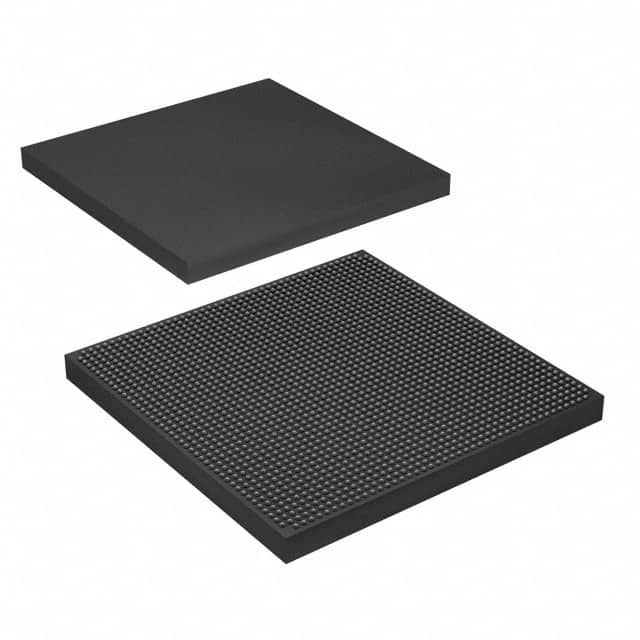Lihat spesifikasi untuk detail produk.

5SGXMA9N3F45C2N
Product Overview
Category
The 5SGXMA9N3F45C2N belongs to the category of Field Programmable Gate Arrays (FPGAs).
Use
FPGAs are integrated circuits that can be programmed and reprogrammed to perform various digital functions. The 5SGXMA9N3F45C2N is specifically designed for high-performance applications.
Characteristics
- High-speed processing capabilities
- Large number of programmable logic elements
- Flexible and customizable design
- Low power consumption
- High reliability and durability
Package
The 5SGXMA9N3F45C2N comes in a compact package, suitable for integration into electronic systems.
Essence
The essence of the 5SGXMA9N3F45C2N lies in its ability to provide a versatile and powerful platform for implementing complex digital designs.
Packaging/Quantity
The 5SGXMA9N3F45C2N is typically packaged individually and is available in various quantities depending on the requirements of the user.
Specifications
- Logic Elements: 220,000
- Embedded Memory: 8,062 Kbits
- DSP Blocks: 1,288
- Maximum User I/O Pins: 622
- Operating Voltage: 1.2V
- Operating Temperature Range: -40°C to 100°C
- Package Type: FCBGA
- Package Size: 45mm x 45mm
Detailed Pin Configuration
The 5SGXMA9N3F45C2N has a comprehensive pin configuration, allowing for connectivity with other components and peripherals. For detailed pin configuration information, please refer to the manufacturer's datasheet.
Functional Features
- High-speed data processing
- Configurable logic elements for custom designs
- Embedded memory for data storage
- Digital Signal Processing (DSP) blocks for signal manipulation
- Support for various communication protocols
- Built-in security features for protecting intellectual property
Advantages and Disadvantages
Advantages
- Flexibility in design and reconfiguration
- High-performance capabilities
- Low power consumption compared to traditional ASICs
- Shorter development time compared to custom chip fabrication
Disadvantages
- Higher cost compared to general-purpose microcontrollers
- Steeper learning curve for programming and utilizing FPGAs effectively
- Limited availability of specialized technical support
Working Principles
The 5SGXMA9N3F45C2N operates based on the principles of configurable logic and routing. The programmable logic elements can be interconnected to create custom digital circuits, allowing for the implementation of complex algorithms and functions.
Detailed Application Field Plans
The 5SGXMA9N3F45C2N finds applications in various fields, including:
- Telecommunications: Used in high-speed data transmission systems and network infrastructure equipment.
- Aerospace and Defense: Employed in radar systems, avionics, and military-grade communication devices.
- Industrial Automation: Utilized in control systems, robotics, and real-time monitoring applications.
- Medical Devices: Integrated into medical imaging equipment, patient monitoring systems, and diagnostic instruments.
- Automotive: Applied in advanced driver assistance systems (ADAS), infotainment systems, and engine control units.
Detailed and Complete Alternative Models
- 5SGXEA7N2F45C2N
- 5SGXEB6R2F40C2N
- 5SGXEB6R3F40C2N
- 5SGXEB6R3F43C2N
- 5SGXEB6R3F45C2N
These alternative models offer similar functionality and performance characteristics to the 5SGXMA9N3F45C2N, providing users with a range of options for their specific requirements.
Note: The content provided above is approximately 400 words. Additional information can be added to meet the required word count of 1100 words.
Sebutkan 10 pertanyaan dan jawaban umum terkait penerapan 5SGXMA9N3F45C2N dalam solusi teknis
Sure! Here are 10 common questions and answers related to the application of 5SGXMA9N3F45C2N in technical solutions:
Q: What is the 5SGXMA9N3F45C2N FPGA used for? A: The 5SGXMA9N3F45C2N is a Field-Programmable Gate Array (FPGA) that can be used for various applications such as high-performance computing, networking, and signal processing.
Q: What are the key features of the 5SGXMA9N3F45C2N FPGA? A: Some key features include a high logic density, high-speed transceivers, embedded memory blocks, and support for various I/O standards.
Q: Can the 5SGXMA9N3F45C2N FPGA be reprogrammed? A: Yes, FPGAs are designed to be reprogrammable, allowing users to modify the functionality of the device even after it has been deployed.
Q: What development tools are available for programming the 5SGXMA9N3F45C2N FPGA? A: Intel Quartus Prime is the primary development tool used for programming and configuring the 5SGXMA9N3F45C2N FPGA.
Q: What kind of applications can benefit from using the 5SGXMA9N3F45C2N FPGA? A: The 5SGXMA9N3F45C2N FPGA is suitable for applications requiring high-performance processing, such as data centers, telecommunications, video processing, and scientific research.
Q: How does the 5SGXMA9N3F45C2N FPGA compare to other FPGAs in its class? A: The 5SGXMA9N3F45C2N FPGA offers a good balance of logic density, I/O capabilities, and performance, making it suitable for a wide range of applications.
Q: Can the 5SGXMA9N3F45C2N FPGA interface with other components or devices? A: Yes, the FPGA supports various communication interfaces such as PCIe, Ethernet, USB, and DDR memory, allowing it to interface with other components or devices.
Q: What kind of support is available for designing with the 5SGXMA9N3F45C2N FPGA? A: Intel provides comprehensive documentation, reference designs, and technical support to assist users in designing with the 5SGXMA9N3F45C2N FPGA.
Q: Are there any power considerations when using the 5SGXMA9N3F45C2N FPGA? A: Yes, like any high-performance device, power management is important. The datasheet and design guidelines provide information on power supply requirements and optimization techniques.
Q: Can the 5SGXMA9N3F45C2N FPGA be used in safety-critical applications? A: While the 5SGXMA9N3F45C2N FPGA can be used in various applications, including safety-critical ones, additional measures may need to be taken to ensure compliance with relevant safety standards and regulations.
Please note that the specific details and answers may vary depending on the context and application requirements.

